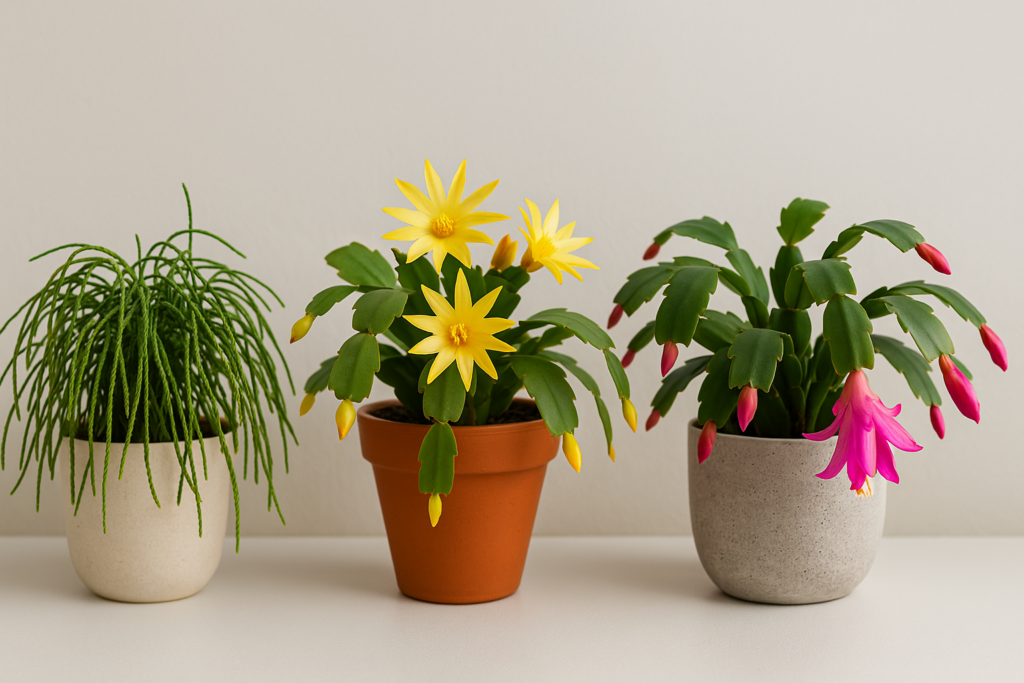Cacti That Love the Shade: Rhipsalis, Hatiora, and Schlumbergera for Low-Light Environments
Discover how to bring more greenery into your home with these unique tropical cactus species.

Have you ever given up on growing plants at home because you thought they needed lots of natural light? Many people believe that cacti only survive in direct sunlight, in hot, arid places. But what if I told you that some cacti actually prefer the opposite?
Yes, there are incredible species that thrive in low-light environments, like rooms with small windows, offices, bathrooms, and even kitchens with indirect light. These are known as tropical epiphytic cacti, and they can transform your dim spaces into vibrant green retreats full of beauty and tranquility.
Among the stars of this category are three surprisingly adaptable species: Rhipsalis, Hatiora, and Schlumbergera. Low-maintenance, resilient, and elegant, these plants are perfect for anyone who wants a touch of greenery without complicated care routines.
In this article, you’ll discover everything you need to know about these plants — from their origins to how to care for them — and learn why they’re the perfect green companions for homes with limited natural light. Let’s dive in!
The Beauty of Tropical Shade-Loving Cacti
When we think of cacti, most of us picture vast deserts, intense sunlight, and dry soil. But the world of cacti is far more diverse than that. Some species not only tolerate but actually prefer to live in shady, humid environments, like the upper branches of trees in tropical forests.
These unusual cacti are called epiphytes. Unlike their desert relatives, they don’t grow in dry soil but cling to trees, absorbing moisture and nutrients from the air and surrounding organic matter. This includes Rhipsalis, Hatiora, and Schlumbergera — all masters of botanical adaptation.
These species are perfect for indoor settings because they naturally thrive in filtered light, just like what you’d find beneath the canopy of a rainforest. Recreating that kind of environment in apartments or offices is easier than you might think.
They also bring distinct textures, stunning flowers, and a subtle elegance, making them ideal for those who want stylish greenery without fuss. If you’re looking for beauty, low maintenance, and adaptability in low-light conditions, these cacti are a true hidden gem.
Rhipsalis: The Delicate Fern-Like Cactus
Rhipsalis is one of the most beloved tropical cacti — and one of the most surprising. Native to Brazil’s Atlantic Forest, this plant defies all cactus stereotypes: it has no spines, loves the shade, and has a delicate appearance similar to a fern.
Its long, trailing stems are thin and graceful, often producing small white or yellow flowers. Some species even develop little translucent berries. Rhipsalis is perfect for hanging pots or high shelves, where its cascading form creates a soft, organic aesthetic.
Caring for it is simple: it prefers indirect light, well-draining soil, and moderate watering. A key tip: avoid overwatering. Like most cacti, Rhipsalis stores moisture in its stems and prefers the soil to dry slightly between waterings.
It adapts well to many parts of the home — from living rooms and hallways to ventilated bathrooms and kitchens. For visual inspiration on how to style your space with Rhipsalis, check out Pinterest.
Hatiora: The Colorful Cactus That Surprises
Hatiora is the kind of plant that impresses with both its shape and its vibrant colors. It belongs to the same family as Schlumbergera and Rhipsalis but has its own unique charm. Its segmented stems — either cylindrical or flat, depending on the species — make it visually striking.
But what really makes Hatiora stand out is its bright and cheerful flowering. It typically blooms in yellows and oranges during late autumn or early winter, when most plants are going dormant. This makes it perfect for bringing life and energy to your home during the colder months.
Despite its colorful display, Hatiora does not need direct sunlight to bloom. Bright, indirect light from an east- or south-facing window works perfectly. And during the flowering period, it prefers the soil to be slightly moist — just be careful not to overwater.
Hatiora is ideal for tabletops, bookshelves, or even vertical gardens. With its modern, slightly sculptural look, it pairs well with minimalist, boho, or tropical decor, adding a splash of color without overpowering the space.
If you’re looking for a bold yet low-maintenance cactus, Hatiora is a fantastic choice.
Schlumbergera: The Famous Christmas Cactus
Schlumbergera, also known as the Christmas cactus, is perhaps the best-known of the shade-loving cacti. Its nickname comes from its habit of blooming spectacularly during the holiday season — making it a festive favorite around the world.
It features flat, jointed stems with slightly serrated edges and produces large, colorful flowers in shades of pink, red, white, orange, or purple. These dramatic blooms appear at the tips of its stems and can last for several weeks with proper care.
Schlumbergera is native to Brazil’s tropical forests, where it grows high up in the trees, away from harsh sunlight. This means it thrives in diffused light and humid conditions, like a bright kitchen or a softly lit living room.
To encourage blooming, give your plant a short period of rest: expose it to cooler temperatures (50°F–59°F / 10°C–15°C) and fewer daylight hours. Once flower buds appear, increase watering slightly and avoid moving the pot, as changes in environment can cause the buds to drop.
Schlumbergera makes a wonderful holiday gift and, with consistent care, will bloom year after year — becoming a treasured part of your home’s seasonal traditions.
Low Light ≠ No Light: Creating the Ideal Setup
It’s a common misconception that “low light” means “total darkness.” But there’s an important distinction: tropical cacti like Rhipsalis, Hatiora, and Schlumbergera don’t need direct sun, but they do need some light — especially the soft, filtered kind.
If you live in an apartment facing north or with limited windows, that doesn’t mean you can’t grow plants. In fact, it’s all about observing how light enters your space and placing your plants strategically.
These cacti thrive in:
- Windows with sheer curtains (filtered light is ideal)
- Shelves close to natural but indirect light
- Bathrooms or kitchens with skylights or frosted glass
- Offices with moderate, consistent natural light
You can also use grow lights to mimic sunlight indoors. These full-spectrum lamps provide the right wavelength for photosynthesis and can be set on timers to mimic natural day cycles.
Pro tip: pay attention to leaf color. If the plant looks pale or yellowish, it might be getting too much light. If it looks droopy, leggy, or leans toward the window, it’s probably asking for more.
Essential Care: Watering, Soil, and Pruning
Although they need less light, these tropical cacti still have specific care needs — and understanding them is the key to keeping your plants healthy and happy.
🌱 Watering
Unlike desert cacti, Rhipsalis, Hatiora, and Schlumbergera prefer slightly moist environments, but never soggy. Water only when the soil is dry on the surface, using a light touch and avoiding water buildup at the bottom of the pot.
In summer, water once or twice a week. In winter, reduce to every 10–15 days depending on humidity.
🪴 Soil
Use a light, well-draining soil mix that mimics their natural habitat. A good mix includes:
- 1 part potting soil or compost
- 1 part coarse sand or perlite
- 1 part coconut fiber or humus
Avoid compact or clay-heavy soil, which retains too much water and can lead to root rot.
✂️ Pruning
Prune to shape the plant, remove damaged parts, or stimulate new growth. Always use clean, sharp scissors or pruners, and cut only dry or old segments that are affecting the plant’s shape.
Bonus: pruning gives you the perfect chance to propagate new cuttings — which leads us to the next section.
How to Multiply Your Favorite Cacti
One of the greatest joys of growing plants is watching them multiply. And with Rhipsalis, Hatiora, and Schlumbergera, propagating at home is easier than you think — and can even become a therapeutic hobby (or a thoughtful gift for a friend).
All three of these species can be propagated through stem cuttings, using a healthy segment from the mother plant.
Step-by-step propagation:
- Choose the right segment: it should be healthy, firm, and blemish-free.
- Cut carefully: use clean scissors and cut at a natural joint between segments.
- Let it dry: allow the cutting to “heal” for 24 to 48 hours in a dry, shaded place.
- Plant in light soil: insert the segment into a small pot with the same well-draining mix used for the adult plant.
- Water lightly: mist the soil lightly in the first few days, avoiding overwatering. After 2–3 weeks, roots should begin to develop.
This method works well for all three species, especially Rhipsalis, which roots quickly. Over time, you can grow entire pots from a single plant, expanding your collection without spending a dime.
To encourage faster rooting, you can even use natural rooting aids like lentil water or cinnamon extract — simple and affordable home solutions.
Why Having Plants in Low-Light Spaces Is Therapeutic
Growing plants in dimly lit areas isn’t just a decorative solution — it can also be an emotional and therapeutic experience, especially for people living in urban settings, small apartments, or enclosed workspaces.
Bringing greenery indoors promotes well-being in many ways:
- Reduces stress and creates a sense of calm and comfort
- Boosts creativity and focus, making it ideal for work or study environments
- Brings life and movement to your space, even on gloomy days
- Reinforces a sense of connection to nature, encouraging mindful rituals and care
These small rituals — watering, pruning, watching new growth emerge — become emotional anchors. They remind us to pause, breathe, and reconnect with what matters.
It’s as if each new sprout is saying, “life is still blooming — even slowly.” And in the hectic pace of modern life, that message can be incredibly powerful.
Conclusion
Throughout this article, we’ve seen that growing beautiful, healthy, and even flowering plants doesn’t require constant sunlight. In fact, with the right species, you can turn dim corners into lush green sanctuaries.
Rhipsalis impresses with its airy, cascading stems. Hatiora adds bold color and modern flair. And Schlumbergera, with its Christmas blooms, proves that even the shade can sparkle.
If you’re just starting your plant journey — or looking to expand your collection with easy, low-maintenance species — these three tropical cacti are the perfect companions. They adapt, charm, and above all, remind us that life can thrive even in low light.
Now tell me: which one will get a special spot in your home?
Feel free to share this article with that friend who always says, “I can’t take care of any plants!” — maybe they just need the right plant in the right place.
Recommended Content: Best Indoor Plants for Your Home

